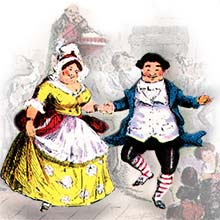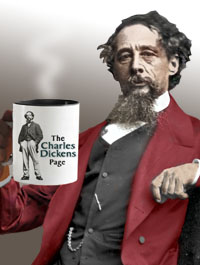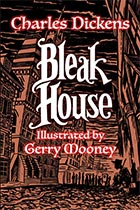The Charles Dickens Page
Bringing the genius of Charles Dickens to a new generation of readers since 1997
Charles Dickens. The name conjures up visions of plum pudding and Christmas punch, quaint coaching inns and cozy firesides, but also of orphaned and starving children, misers, murderers, and abusive schoolmasters. Dickens was 19th century London personified, he survived its mean streets as a child and, largely self-educated, possessed the genius to become the greatest writer of his age.
Learn about Charles Dickens' influence on the celebration of Christmas!
Meet over 1000 Charles Dickens characters, cross referenced, and many with illustrations.
Stumped by a word or phrase while reading Dickens? Find it in our glossary.
Explore Charles Dickens' London with our Dickens' London Map.
Learn what it was like to live in Charles Dickens' London.
Learn about Charles Dickens' life, family, and work through an illustrated hypertext biography.
Learn about Charles Dickens' home Gads Hill Place.
Charles Dickens was born on February 7, 1812, the son of a clerk at the Navy Pay Office. His father, John Dickens, continually living beyond his means, was imprisoned for debt in the Marshalsea in 1824. 12-year-old Charles was removed from school and sent to work at a boot-blacking factory earning six shillings a week to help support the family. This dark experience cast a shadow over the clever, sensitive boy that became a defining experience in his life, he would later write "It is wonderful to me how I could have been so easily cast away at such an age" (Forster, 1899, v. 1, p. 25).
This childhood poverty and feelings of abandonment, although unknown to his readers until after his death, would be a heavy influence on Dickens' later views on social reform and the world he would create through his fiction.
Dickens would go on to write 15 major novels including, Oliver Twist, Bleak House, Great Expectations, A Tale of Two Cities, and his personal favorite, David Copperfield. He will forever be associated with the celebration of Christmas due to his Christmas Books, the most popular being A Christmas Carol. Dickens also edited, and contributed to, weekly journals Household Words and All the Year Round. Near the end of his life he traveled throughout Britain and America giving public readings of his work.
Charles Dickens died an old man of 57, worn out with work and travel, on June 9, 1870. He wished to be buried, without fanfare, in a small cemetery in Rochester, Kent, but the Nation would not allow it. He was laid to rest in Poet's Corner, Westminster Abbey, the flowers from thousands of mourners overflowing the open grave. Among the more beautiful bouquets were many simple clusters of wildflowers, wrapped in rags.
Annotated A Christmas Carol
Dickens pared down A Christmas Carol for his public readings. Read an annotated version of Dickens' own reading text that can be read in a single sitting!
The Many Faces of Ebenezer Scrooge
The Internet Movie Database lists more than 100 actors who have portrayed the famous Dickensian miser. Some of the best are pictured here.
Bits of Dickens...
Short examples of Charles Dickens' work that can be read in a single sitting:
- Oliver Asks for More (Oliver Twist)
- Cratchit's Christmas (A Christmas Carol)
- Steamboat Trip (American Notes)
- Omnibuses (Sketches by Boz)
- Mrs Gamp (Martin Chuzzlewit)
- The Haves and the Have Nots (American Notes)
- Mr Pickwick Meets the Lady in Yellow Curl Papers (Pickwick Papers)
- More Bits of Dickens
Explore the World of Charles Dickens with Maps
- Charles Dickens' London
- Aerial Charles Dickens' London
- Dickens' Rochester/Chatham
- Dickens' Higham
- Dickens' American Travels 1842
- Dickens' American Reading Tour 1867-68
- Dickens' Pictures from Italy Map 1844-45
- Oliver Twist Map - London Locations
- Oliver Twist Map - Outside London
- A Tale of Two Cities - London
- A Tale of Two Cities - Paris
- Great Expectations Connections
- Dickens' Reading Tour of England, Scotland, and Ireland 1858
- Map of Nell's Journey from The Old Curiosity Shop
- The London of Barnaby Rudge
- London Map of Dickens' Night Walks
- London Locations in Bleak House
- Pickwickian Travels
Sir Roger de Coverley

The fiddler struck up Sir Roger de Coverley. Then old Fezziwig stood out to dance with Mrs Fezziwig. Top couple, too; with a good stiff piece of work cut out for them.
The dance performed by Fezziwig and company was popular in the eighteenth century and was considered old-fashioned by Dickens' time. Named for a ficticious character in The Spectator (1711) the dance resembled the Virginia Reel. It was usually the last dance performed during an evening of entertainment (Hearn, 2004, pp. 70-71, n. 52).
 Learn the dance
Learn the dance
Hear the music
Railway Crash!
 Charles Dickens, Henry Benge, and the Great Staplehurst Railway Crash
Charles Dickens, Henry Benge, and the Great Staplehurst Railway Crash
Read the story of how a simple mistake took the lives of ten people, ruined the life of Henry Benge, and shortened the life of Charles Dickens.
Boz Spotlight
Dickens' classic featuring 40 all-new linoleum cut illustrations by award winning illustrator Gerry Mooney
Cursing in Dickens
As the stricter morals of the Victorian era replaced the ribaldry of the 18th-century,  Dickens felt compelled to clean up his act. Instances of cursing in the novels dropped dramatically in his mid and late career. For example, below is a count of the full-use of the word "damn" (as opposed to just a capital D or d--d for damn or damned) in Dickens' works:
Dickens felt compelled to clean up his act. Instances of cursing in the novels dropped dramatically in his mid and late career. For example, below is a count of the full-use of the word "damn" (as opposed to just a capital D or d--d for damn or damned) in Dickens' works:
7 - Sketches by Boz
29 - Pickwick Papers
12 - Nicholas Nickleby
8 - Barnaby Rudge
1 - David Copperfield
3 - Bleak House
3 - Hard Times
3 - Little Dorrit
1 - Tale of Two Cities
3 - Great Expectations
1 - Our Mutual Friend
2 - Edwin Drood
Learn more about Charles Dickens
Life
Places
- The Charles Dickens Museum
- Dickens' Birthplace Museum
- Gads Hill Place
- The Cleveland Street Workhouse
- Charles Dickens Cigarette Cards
Characters
Organizations
Special Guests
My Favorite Places
- Gina Dalfonzo's DickensBlog
- Where was Dickens?
- Charles Dickens Info
- The Victorian Dictionary
- The Victorian Web
- Charles Dickens' Journals Online
- Charles Dickens' Letters

In the Charles Dickens tradition of helping the needy and the sick this site supports
 St. Jude Children's Research Hospital
St. Jude Children's Research Hospital Finding cures. Saving children.




















